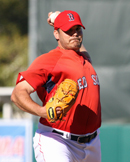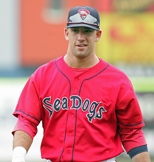February 26, 2009 at 10:11 AM
2009 Prospect Previews: Hunter Jones and Ryan Kalish


 |
|
|
|
|
 |
|
|
|
SoxProspects News |


 Fifteen players from the Red Sox organization - six major leaguers and nine minor leaguers - have been named to the final World Baseball Classic rosters, which were released on Tuesday night. The Sox players assigned to WBC rosters are:
Fifteen players from the Red Sox organization - six major leaguers and nine minor leaguers - have been named to the final World Baseball Classic rosters, which were released on Tuesday night. The Sox players assigned to WBC rosters are:
The first round of the WBC kicks off on March 5, with the sixteen teams split into four pools and games in Tokyo, Mexico City, Toronto, and San Juan. The top two teams from each pool will qualify for the second round, which will be held from March 14-19 in San Diego and Miami. The semi-finals will then be held on March 21 and 22 in Los Angeles, followed by the finals on March 22, also in Los Angeles. Check out the WBC official site for a full schedule.
 Nearly every level of the Red Sox farm system boasts one or two intriguing shortstop prospects. Four of the top 20 Red Sox prospects, as ranked by SoxProspects.com, are shortstops, and two or three other talents in the lower minors could jump into that group with solid seasons. By design, the top infielders in the system stay at short as long as possible, or until forced from the position by a more highly-touted prospect.
Nearly every level of the Red Sox farm system boasts one or two intriguing shortstop prospects. Four of the top 20 Red Sox prospects, as ranked by SoxProspects.com, are shortstops, and two or three other talents in the lower minors could jump into that group with solid seasons. By design, the top infielders in the system stay at short as long as possible, or until forced from the position by a more highly-touted prospect.
Lots of minor league notes over the past couple days ... The Providence Journal brings us a report on Daniel Bard, who is trying to channel the adrenaline rush he gets from facing big league hitters for the first time into increased intensity on the mound ... Bard has impressed Terry Francona with his slider, and also plans to work on developing his change-up in 2009, this according to Rob Bradford of WEEI.com ... Bradford also reports that pitching coach John Farrell has been most impressed with Kris Johnson and Junichi Tazawa so far this spring ... According to Bradford, Farrell has been pleasantly surprised by Tazawa's command and mature demeanor, and Johnson's advanced arsenal and the movement on his fastball ... Johnson hopes to tighten up his breaking ball and slow down his change-up a bit in 2009 ... The Red Sox have let Clay Buchholz return to the natural over-the-top arm slot that he used in 2007 .. So far Buchholz has impressed with increased command, control, and confidence ... Adam Mills has been added as a non-roster invitee to big league camp ... Mills, Johnson, and Enrique Gonzalez are apparently all vying for the final spot in Pawtucket's rotation, but another rotation spot could open up in Pawtucket if Devern Hansack is moved to the PawSox bullpen - where he could more likely contribute to the big league club in 2009 ... Dusty Brown has apparently impressed in batting practice this spring, showing increased home run power ... We should have some decisions on WBC rosters come Wednesday - among players in the Sox organization, look for Dustin Pedroia and Kevin Youkilis to represent the United States, Jason Bay to play for team Canada, Daisuke Matsuzaka to take the hill for Japan, Enrique Gonzalez to pitch for Venezuela, Mitch Dening to play for Australia, and Che-Hsuan Lin and Chih-Hsien Chiang to play for Taiwan ... The Boston Herald reports that bullpen coach Gary Tuck continues his annual "dropped-ball" competition among catchers in camp, where the catchers keep track of how many pitches they've dropped (not counting knuckleballs from Tim Wakefield and Charlie Zink) ... Carlos Maldanado is in the lead without any drops, and Mark Wagner and Jason Varitek come in next with only one drop each ... George Kottaras won the competition in 2008 ... Jon Lester mistakenly drilled Brad Wilkerson in the back on Sunday, leaving a noticeable bruise ... Rule 5 pick Miguel Gonzalez felt some discomfort in his elbow on Saturday, and was held back from finishing a side session as a precautionary measure ... Gonzalez sat out the rest of the weekend and took some anti-inflamatories, but is now scheduled to have an x-ray to determine if there is any damage in his elbow ... He will miss about five days ... The big league spring training game schedule kicks off on Wednesday, and Boston's initial rotation will be Josh Beckett, Wakefield, and Lester, followed by Michael Bowden, Johnson, and Buchholz ... ... Bowden will take the mound on Friday night against Tampa Bay, Johnson will pitch against Northeastern on Saturday afternoon, and Buchholz will toe the rubber against the Reds on Saturday night ... Minor league mini-camp opens today, with certain players who were slected to participate ... All minor leaguer pitchers and catchers are required to report on March 6 ... Positon players are required to report on March 13 ... Full squad workouts begin on March 15 ... The minor league game schedule begins against the Minnesota farm teams on March 18.
 Continuing our preseason organization outlook, we come to the second basemen. For this installment, we will also cover a few players who could be categorized in the “utility infielder” category. Second base is a relatively thin position in the Sox organization based on ranking, with no player expected to play that position full time ranked in the SoxProspects.com Top 40. There are two possible explanations: (1) the Red Sox rarely sign “true second basemen”, perhaps figuring a high-level shortstop could always move to second if the need arises, and (2) the team’s second baseman of the future is already in Boston. Here’s the list of second basemen and utility infielders, sorted by highest level reached last season:
Continuing our preseason organization outlook, we come to the second basemen. For this installment, we will also cover a few players who could be categorized in the “utility infielder” category. Second base is a relatively thin position in the Sox organization based on ranking, with no player expected to play that position full time ranked in the SoxProspects.com Top 40. There are two possible explanations: (1) the Red Sox rarely sign “true second basemen”, perhaps figuring a high-level shortstop could always move to second if the need arises, and (2) the team’s second baseman of the future is already in Boston. Here’s the list of second basemen and utility infielders, sorted by highest level reached last season:
 Hunter Strickland
Hunter Strickland  Mark Wagner
Mark WagnerWritten by Chris Mellen
News and notes from the Sox Minor League Complex: Felix Doubront missed a few days of practice last week with a sore back - no word on whether the injury continues to linger ... A slimmed-down Chris Carter is back taking grounders at first base after strictly playing left field and designated hitter in 2008 ... He's still having a few issues with the glove at first, but we've heard several raves about Carter's conditioning and work ethic over the off-season and this Spring ... Josh Reddick appears to have bulked up some over the off-season, and he's been driving the ball well to all fields in batting practice ... To no one's surprise, Lars Anderson still loves to hit to the opposite field - can't wait to see him lining balls off the Green Monster on a regular basis ... Zach Daeges' frame is looking solid, and he continues to smoke liner shots in batting practice, but without a lot of home run loft ... Michael Bowden has hinted to Nick Cafardo that the Sox might be working on adding a new pitch into Bowden's arsenal ... Paul McAnulty, signed to a minor league deal in November, was originally signed by Red Sox amateur scouting director Jason McLeod in June 2002, who at the time was a scout with the Padres ... According to Alex Speier of WEEI.com, McAnulty was McLeod's first-ever signing ... The Brad Wilkerson signing became official earlier this week, and he's working out with the major league club hoping to fill the void left by Mark Kotsay, who reportedly hopes to return from his back injury in early May ... Jed Lowrie, back to full form from his wrist injury, indicates that the injury hampered his ability to turn on the ball, direct his swing, or hit with any sort of power in the final months of the 2008 season ... Lowrie opted to take some time off over the winter to let the injury heal, rather than surgery, which would have caused him to miss spring training ... According to SoxProspects community reports, Jacoby Ellsbury looks bigger muscularly across the back and shoulders ... David Ortiz looks to have lost about 10-15 pounds ... According to other community reports, Justin Masterson, Jonathan Papelbon, Justin Masterson, Hideki Okajima, Manny Delcarmen, Wes Littleton, and Hunter Jones took lots of time out of their schedules to sign autographs for several young fans.
 Brock Huntzinger
Brock Huntzinger Ryan Lavarnway
Ryan Lavarnway
 Stephen Fife
Stephen Fife Oscar Tejeda
Oscar Tejeda
